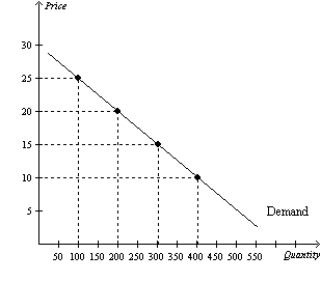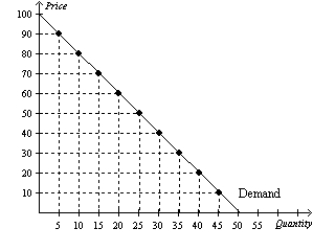A) negative, and the good is an inferior good.
B) negative, and the good is a normal good.
C) positive, and the good is a normal good.
D) positive, and the good is an inferior good.
Correct Answer

verified
Correct Answer
verified
Multiple Choice
Which of the following is likely to have the most price inelastic demand?
A) athletic shoes
B) running shoes
C) Nike running shoes
D) Nike Shox running shoes
Correct Answer

verified
Correct Answer
verified
True/False
A government program that reduces land under cultivation hurts farmers but helps consumers.
Correct Answer

verified
Correct Answer
verified
True/False
Necessities tend to have inelastic demands, whereas luxuries tend to have elastic demands.
Correct Answer

verified
Correct Answer
verified
Multiple Choice
Table 5-4
The following table shows the demand schedule for a particular good.  -Refer to Table 5-4. Using the midpoint method, when price rises from $8 to $12, the price elasticity of demand is
-Refer to Table 5-4. Using the midpoint method, when price rises from $8 to $12, the price elasticity of demand is
A) 0.4
B) 1
C) 1.5
D) 2.33
Correct Answer

verified
Correct Answer
verified
Multiple Choice
Charles purchases 20 basketball tickets per year when his annual income is $50,000 and 25 basketball tickets when his annual income is $60,000. Charles's income elasticity of demand for basketball ticket is
A) 0.82, and basketball tickets are a normal good.
B) 0.82, and basketball tickets are an inferior good.
C) 1.22, and basketball tickets are a normal good.
D) 1.22, and basketball tickets are an inferior good.
Correct Answer

verified
Correct Answer
verified
Multiple Choice
Total revenue will be at its largest value on a linear demand curve at the
A) top of the curve, where prices are highest.
B) midpoint of the curve.
C) low end of the curve, where quantity demanded is highest.
D) None of the above is correct.
Correct Answer

verified
Correct Answer
verified
Multiple Choice
If the price elasticity of supply is 1.2, and price increased by 5%, quantity supplied would
A) increase by 4.2%.
B) increase by 6%.
C) decrease by 4.2%.
D) decrease by 6%.
Correct Answer

verified
Correct Answer
verified
Multiple Choice
Figure 5-8  -Refer to Figure 5-8. When the price is $15, total revenue is
-Refer to Figure 5-8. When the price is $15, total revenue is
A) $1,500.
B) $2,500.
C) $3,500.
D) $4,500.
Correct Answer

verified
Correct Answer
verified
Multiple Choice
Food and clothing tend to have
A) small income elasticities because consumers, regardless of their incomes, choose to buy relatively constant quantities of these goods.
B) small income elasticities because consumers buy proportionately more of both goods at higher income levels than they buy at low income levels.
C) large income elasticities because they are necessities.
D) large income elasticities because they are relatively inexpensive.
Correct Answer

verified
Correct Answer
verified
Multiple Choice
Get Smart University is contemplating an increase in tuition to enhance revenue. If GSU feels that raising tuition would enhance revenue, it is
A) ignoring the law of demand.
B) assuming that the demand for university education is elastic.
C) assuming that the demand for university education is inelastic.
D) assuming that the supply of university education is elastic.
Correct Answer

verified
Correct Answer
verified
Multiple Choice
Heath's income elasticity of demand for concerts is 2. All else equal, this means that if his income increases by 10 percent, he will purchase tickets for
A) 2 percent more concerts.
B) 5 percent more concerts.
C) 10 percent more concerts.
D) 20 percent more concerts.
Correct Answer

verified
Correct Answer
verified
Multiple Choice
If the price elasticity of demand is 1.5, regardless of which two points on the demand curve are used to compute the elasticity, then demand is
A) perfectly inelastic, and the demand curve is vertical.
B) elastic, and the demand curve is a straight, downward-sloping line.
C) perfectly elastic, and the demand curve is horizontal.
D) elastic, and the demand curve is something other than a straight, downward-sloping line.
Correct Answer

verified
Correct Answer
verified
Multiple Choice
Suppose good X has a positive income elasticity of demand. This implies that good X could be
A) (i) only
B) (i) and (ii) only
C) (i) , (ii) , and (iv) only
D) (iii) only
Correct Answer

verified
Correct Answer
verified
Short Answer
Refer to Table 5-12. Between which two quantities listed is demand unit elastic?
Correct Answer

verified
Correct Answer
verified
Short Answer
Refer to Table 5-12. Between which two quantities listed is demand most inelastic?
Correct Answer

verified
Correct Answer
verified
Multiple Choice
Economists compute the price elasticity of demand as the
A) percentage change in price divided by the percentage change in quantity demanded.
B) change in quantity demanded divided by the change in the price.
C) percentage change in quantity demanded divided by the percentage change in price.
D) percentage change in quantity demanded divided by the percentage change in income.
Correct Answer

verified
Correct Answer
verified
Multiple Choice
Figure 5-5  -Refer to Figure 5-5. At a price of $10 per unit, sellers' total revenue equals
-Refer to Figure 5-5. At a price of $10 per unit, sellers' total revenue equals
A) $100.
B) $450
C) $500.
D) $1250.
Correct Answer

verified
Correct Answer
verified
Multiple Choice
Table 5-4
The following table shows the demand schedule for a particular good.  -Refer to Table 5-4. Using the midpoint method, what is the price elasticity of demand when price rises from $12 to $16?
-Refer to Table 5-4. Using the midpoint method, what is the price elasticity of demand when price rises from $12 to $16?
A) 0.43
B) 0.67
C) 2.33
D) 4
Correct Answer

verified
Correct Answer
verified
True/False
The demand for soap is more elastic than the demand for Dove soap.
Correct Answer

verified
Correct Answer
verified
Showing 121 - 140 of 594
Related Exams